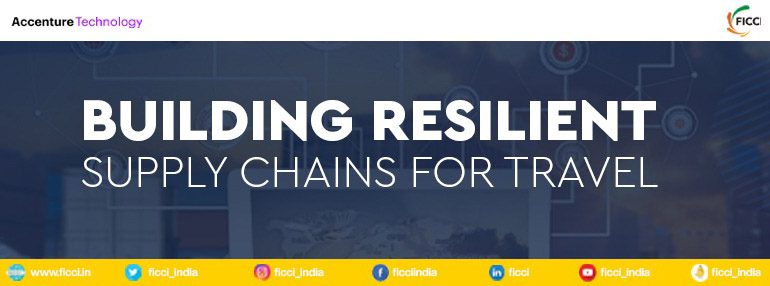
In this third article of the series on cross-industry lessons on revival for the travel sector, we explore what travel can learn from the way other industries created resilient supply chains to stimulate and sustain growth.
Much of the talk on helping travel recover is focused on reviving demand and on reinventing travel to make it safe, contactless, and friction-free and highly personalized. Given the considerable change we foresee as travel resets, it is also time to explore how to make the travel supply chain resilient.
Travel can take lessons in the way global supply chains have weathered tsunamis, earthquakes, terrorist attacks and the current pandemic. As these kinds of events are likely to occur more frequently over the next few years, businesses (especially manufacturers) are re-imagining their supply chains as customer-centric, flexible, transparent, resilient, and intelligent.
We will examine this transformation theme in its various dimensions—such as the how and why of customer centricity, the trade-offs between cost and value that are inevitable in crises, and the need for risk mitigation. These are interdependent steps to the path of building resilience in supply chains.
Lesson 1
Make the customer the focus, not just operational efficiency
With strong demand for customization and faster order fulfilment, most industries, especially retail, are seeing the need to restructure their supply chain. Many supply chain leaders are showing the way, pivoting the focus of their supply chains from cost efficiency to customer experience. These customer-centric supply chain leaders have learned to balance operational excellence and new customer value while adopting a customer outcomes-based culture.
Opt for multiple supply chains for hyper-personalization: We see the emphasis on customer values reflected in the views of supply chain executives who say that traditional linear supply chains designed only for efficiency gains are on their way out. Nearly 80 per cent of supply chain executives in an Accenture study believe that supply chains need to become ‘fit-for-purpose’, based on the value proposition for a particular customer segment.
For example, organizations with local and regional supply chains have the flexibility to cater to evolving customer needs, address shorter order-to-deliver lead times and respond faster to daily signals. Take the case of Kellogs, the food company that had to scramble to ramp up production in Australia following a huge unforeseen spike in demand for its products during the pandemic. The company switched to a packaging materials supplier closer home in New Zealand when its regular supplier in Korea ran out of stock.
Travel businesses too can consider building multiple supply chains in place of the traditional one-size-fits-all model. Large hotel chains could rely on two or three local and regional supply chains of primary and secondary suppliers instead of relying primarily on global suppliers.
Build asset-light models: Another way to manage disruptions in supplies is to build asset-light supply chains like the ones in the manufacturing industry. They access shared assets instead of owning all the supply chain assets through platforms, such as Flexe, which provides on-demand warehousing, and connects companies in need of flexible warehouse storage with businesses looking to monetize their underutilized warehouse space.
Similar asset-light supply chain models can also easily support the new travel paradigm. An exchange platform for buying or selling unused capacity amid highly volatile travel demand could, for example, underpin volatile demand and supply conditions for hotels and airlines.
Establish responsible supply chains: Compelled by environmentally conscious consumers, most industries are increasingly partnering with suppliers who source raw materials and spare parts responsibly and ethically. AB InBev, one of the largest global buyers of barley, leverages a blockchain-based technology platform to help growers improve their barley yields and environmental footprint.
Responsible supply chains also adopt various measures to reduce their carbon footprint and promote sustainability in their ecosystems. For example, Apple plans to eliminate 75 per cent of the emissions across its supply chain and projects by 2030.
As travellers increasingly seek vacation options that affect local economies in a positive and sustainable way, the travel industry will also need to review their supplier base through the green lens. For example, OTAs and hotels could build new contracts with clear specs on green certifications and take cues from the manufacturing industry where companies use blockchain and IoT-based solutions to trace the provenance of their primary and secondary materials.
Lesson 2
Balance short-term costs with long-term customer value
Cost-benefit analysis is never easy, especially in an unknowable future. Still, there are some broad principles to follow such as re-investing saved costs for upskilling front-end facing staff, adopting AI or predictive analytics-based technology solutions, or building some critical inventory buffer. Most businesses, especially manufacturers and retailers, find that digital technology investments pay off fast enough to justify the costs.
Invest in buffer stock of critical parts: The ‘just-in-time’ inventory management principles that enabled efficient processes in the manufacturing sector, for example, was ideal for a predictable environment. But the pandemic has shown that companies that maintained some slack in their inventory managed to tide over the crisis better. The expense (and risk) of holding a buffer stock of critical parts is offset by the fact that without this stock, the time lost in getting the parts often lead to huge: losses in a brand’s reputation.
Similarly, given travel’s experience of long periods of sketchy demand over the last one year followed by sudden spikes, the industry (airlines, hotel chains, and OTAs especially) needs a stock of critical parts to cover demand and supply gaps.
With predictive analytics, AI and ML-based solutions, the airline industry can redeploy underutilized assets, and monitor the health of their inventory of critical spare parts so that these are available in excellent condition when an unforeseen need arises. Hotel companies could also use analytics to address the sudden surge in guest bookings and manage the additional labour requirements much better.
Adopt intelligent forecasting and operations: The ability to forecast demand combined with complete visibility of suppliers are important components of a responsive supply chain and customer centricity. Intelligent supply chains powered by analytics, IoT and automation are helping companies across industries manage complexities and disruptions to their advantage.
Similarly, there is a strong need for travel companies to adopt technology to manage customer demand. The resurgence in travel demand in recent months along with the high probability of last-minute cancellations highlight how OTAs, hotel and airlines could benefit from a reliable demand forecasting model. It would help them gear up their supply chain to meet the demand and give them time to design innovative experiences to attract and retain customers.
Lesson 3
Plan for risk mitigation
The pandemic revealed that global businesses with a regional concentration of suppliers are more vulnerable than others—a bitter lesson that millions of companies with at least one or two tier 2 suppliers in Wuhan, China, learnt early last year. Many are now re-evaluating the geography of their supply chains as part of their plans for risk mitigation
Make supplier networks visible: Manufacturers with transparent supply chains can easily collaborate and coordinate with suppliers and quickly identify and manage disruptions in any part of the supply chain. By digitizing supply chain operations, Nike, for example, could trace the movement of materials in hundreds of factories across the globe and reroute its unused inventory toward online sales as physical stores closed during the lockdown.
The travel industry’s supply chains tend to be opaque in some segments. Therefore, using technologies such as blockchain can make all suppliers and materials movements transparent and help travel companies mitigate the impact of disruptions. Airlines, for example, could use analytics to configure alternate flight routes in case of a natural disaster (as they did after the Icelandic volcano eruption in 2010, which disrupted flights in Northern Europe).
This understanding of supply chain vulnerabilities is a firm foundation for designing effective strategies, including risk mitigation plans which together with buffer stocking can help absorb supply chain shocks
Expand supplier base of hotels: With domestic travel demand on the rise, this is a good time for OTAs to look at diversifying their supplier base to cover the risk of shortages. They could start with hotels. According to HotelRunner, 93 per cent of the 15 million accommodations available globally are not in the OTA network for booking online in real time. Such a massive gap affects the choice of hotels available to travellers. With only the same small group of hotels to offer travellers, OTAs lack the opportunities for designing personalized customer experience. And the millions of hotels not connected to this network miss out on growth opportunities beyond their local markets.
Conclusion: The interplay between the
actions discussed above will help travel companies create customer-centric,
responsible, transparent, and intelligent supply chains to sustain recovery and
prepare for any future disruptions. But a lot of the success in creating a
re-imagined travel supply chain will also depend on the potential for
collaboration with ecosystem partners and with governments on policy issues.






